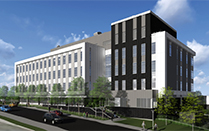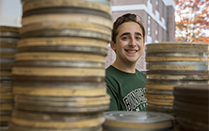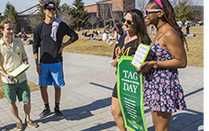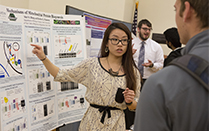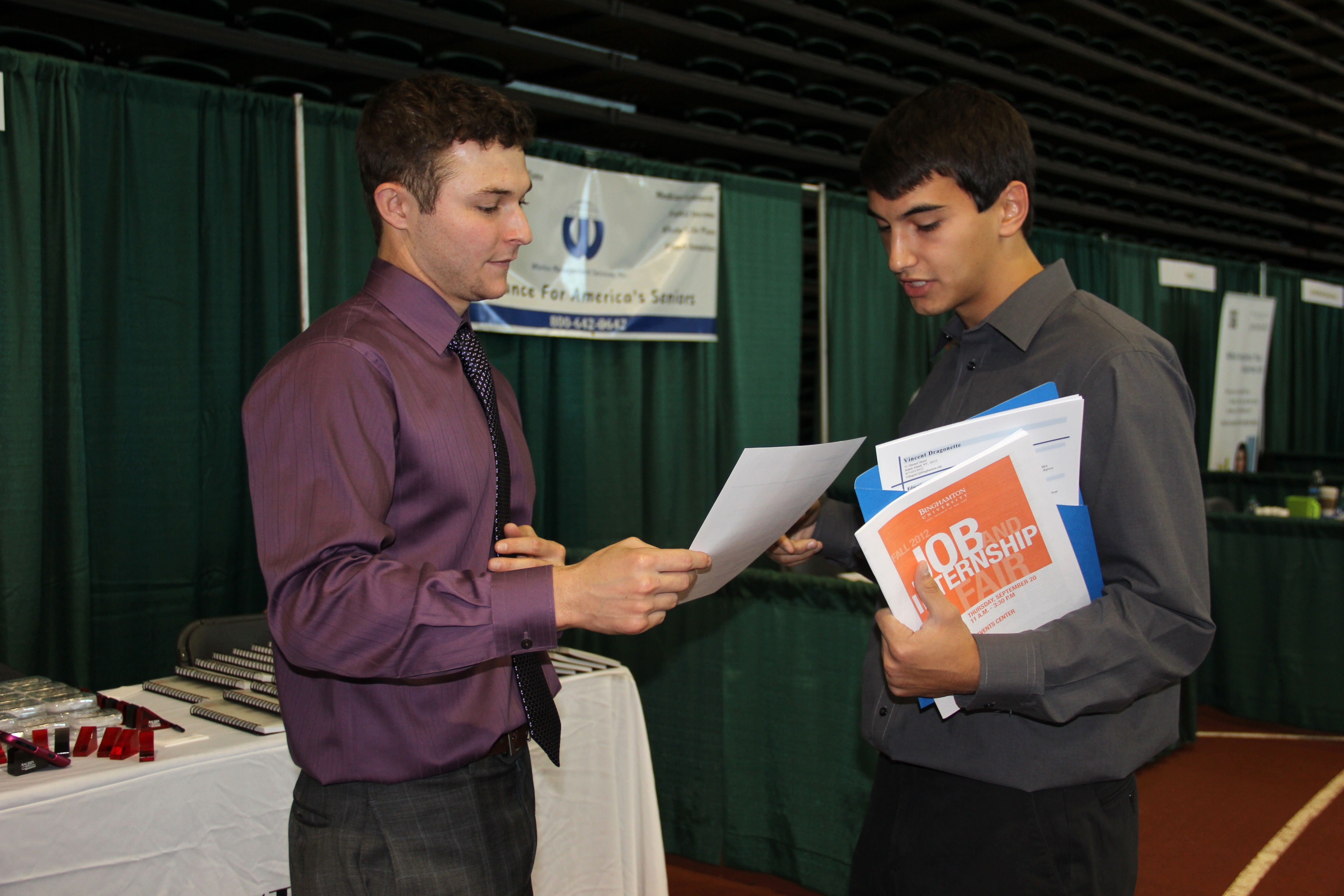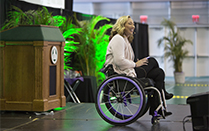Binghamton University President Harvey Stenger's Road Map Quarterly Report - March 31, 2016
The winter quarter ends, appropriately, with students on a well-deserved spring break. For the past several weeks, everywhere I go on campus I see students working hard. They are poring over their books while sitting on benches on the Peace Quad, banging out term papers on their computers in the library and going over their notes in the MarketPlace in preparation for their midterms. The buzz of activity throughout campus is exciting and evidence of our student’s dedication and ambition. At the same time, the demands of academic life can lead to stress and burnout, so it is important that students take time in the middle of the semester to rest and regroup as they get ready for “crunch time” with the end of the semester in sight.
But it is not just the students who have been busy this semester. The entire campus community has been hard at work fulfilling the University’s core missions — education, scholarly and creative work, and outreach. We can point to a number of successes in each of these areas.
Central to these efforts has been the University’s Road Map. For the past four years, we have been committing resources to develop and strengthen our educational activities and our creative and research work, and to build relationships with exterior audiences. This year, we received 76 proposals for funding addressing all of the Road Map’s five strategic priorities. These proposals are currently being reviewed and ranked by Professional Staff Senate, the Faculty Senate Budget Review Committee and the Road Map Steering Committee. With approximately $2 million in one-time funding available, we will be limited in the number of proposals that can be implemented. What I have discovered over the past four years, however, is that many high-quality proposals are reconsidered in following years and often our vice presidents will look for funds within their budgets to cover projects that meet important divisional goals, even if Road Map funding is unavailable. This is important since it shows that the Road Map priorities are influencing the campus well beyond the specific parameters of the Road Map process itself.
Our Educational Mission
Binghamton University’s commitment to quality education is attracting more and more attention. One measure of this is the number of freshman applications we receive. This year, more than 32,000 high school students submitted applications for next fall — up about 5 percent over last year — for only about 2,600 seats. Not only is this number a new record for the University (and almost double that of a decade ago), it occurs at a time when applications both nationally and statewide are decreasing. Part of this increase may be due to the new application process we have implemented, called SLATE, which is both easier to use and provides accessible data for better enrollment management. Our admissions staff is now concentrating on increasing the number of top students who enroll — and these efforts are already paying off, with both the Binghamton Scholars and PricewaterhouseCoopers Scholars programs seeing significant increases in applications. So we can expect next year’s class to be of exceptional quality, with SAT scores over 1300.
Educating advanced students is also a critical part of our work. This has been a key focus of our Road Map since our ability to attract high-quality graduate students is a measure of our reputation for innovative research, scholarship and creative work. So I am pleased that graduate applications are also increasing — as of mid-March completed applications are up 16 percent and deposits are up 20 percent compared to last year.
If you are on campus this time of year, you will notice large numbers of high school students and their families touring the campus. In fact, this year we will see more than 41,000 individuals taking tours conducted by our admissions staff and students. This, too, is a record number and represents a near doubling of the number of visitors compared to a decade ago. Between recruiting, reviewing applications and organizing student tours, our admissions staff and our student tour guides have been extremely busy.
This increase in visits corresponds to the increasing visibility the University is gaining in the popular press, particularly in the ever-important rankings for academic quality and value. Most recently, Buffalo Business First ranked Binghamton first among New York public colleges and universities. Binghamton was the only public university listed in the publication’s ranking of New York’s “most selective” colleges. The publication also named Binghamton the 20th best public in the nation. This represents the highest position the campus has ever received for overall academic quality in a press ranking, which I think is due to a methodology that minimized the list’s subjectivity. The University is also receiving high ratings for other aspects of our educational mission, with the Institute of International Education naming us the 15th “international recruiting” in its annual Open Doors report; similarly, the online publication Greatist.com placing Binghamton among the top 25 “healthiest” campuses.
One of the underlying messages of these rankings is that Binghamton succeeds when it provides instruction and services that are relevant to the changing needs of our students and society. One change that we must respond to is an increasing demand for master’s-level programming. For example, the U.S. Bureau of Labor Statistics (BLS) forecasts an 18.4 percent increase in the number of jobs requiring a master’s degree by the year 2022. For this reason, the University is currently in the process of adding a number of new master’s programs. We’ve recently begun a first-of-its-kind sustainable communities MA/MS program, as well as in public archeology and applied statistics (which has already led to an increase in applications in mathematics). In addition, we are also moving forward on a master’s in applied liberal science, public health and data analytics. We also are adding two new certificate programs: social work in healthcare settings and social work in community schools. Not only do these programs meet the specific career needs of our students, they also will help the campus shift the balance of undergraduate to graduate students being educated at Binghamton and better reflect our role as a research university.
Our Research Mission
Strengthening the University’s role as a research university is also the one of the goals of our new School of Pharmacy and Pharmaceutical Sciences, which is on track to open in 2017, pending precandidate status from the Accreditation Council for Pharmacy Education and approval from the New York State Education Department. Dean Gloria Meredith recently hosted a well-attended Town Hall meeting where she discussed the school’s progress and its expected impact on University research. The school, to be located at 96 Corliss St. in Johnson City, will feature classes in pharmaceutical management, hospital practice and pharmacoeconomics and will house simulation labs and pharmacies. The school has hired several lead administrators, including an assistant dean of experiential education, and is currently recruiting teaching and research faculty. One of the next steps will be to provide for research equipment for the school.
Through the support of the Binghamton University Foundation, the campus also has purchased a building 48 Corliss St. that will be renovated as the new home for the Decker School of Nursing. Together, these buildings will form the heart of the Southern Tier Health Sciences and Technology Innovation Park. We are currently working to bring other academic and industrial partners on board to develop the campus as a dynamic leader in pharmaceutical and healthcare research, development and production. SUNY Upstate Medical University has indicated interest in establishing its clinical campus at these facilities, and we are reaching out to pharmaceutical and healthcare delivery device manufacturers and startups to encourage their participation. Our goal is to develop the campus as a leading nexus for a fast-growing industry, which would provide opportunities for clinical and research experience for our advanced students. Significantly, our admissions office tells me that there is a great deal of interest in the School of Pharmacy and Pharmaceutical Sciences among prospective graduate and undergraduate students.
Attracting high-quality graduate students also depends on the quality of our faculty, and they, too, are doing outstanding research that is attracting national attention. This quarter there have been a number of faculty whose work has been featured in the scientific, scholarly and popular press. For example, Psychology assistant professor Nicole Cameron’s research on the generational impact of fetal alcohol exposure was widely covered, due to the surprising finding that women who drink alcohol while pregnant pass on alcohol resistance (a measure of potential alcoholism) to the third generation. Similarly, anthropology professor Carl Lipo postulates that obsidian artifacts used by Easter Island’s residents were likely farming implements rather than weapons of war, challenging the accepted view among scholars that Easter Island’s civilization declined rapidly as a result of internecine warfare. Instead, Lipo’s work points to European contact, with its attendant disease and slavery, as the cause for the civilization’s demise.
Our Outreach Mission
An important aspect of Binghamton University’s research and educational roles is the impact they have on the local community and New York state. This is certainly one of the objectives of the new health sciences campus, but we have a broader view of outreach that brings together a wide range of University activities. The development of new private/public partnerships involving Binghamton University is a central goal of the Southern Tier Regional Economic Development Council, on which I serve as co-chair.
At the end of last quarter, I was excited to announce that the region had just been named a Best Plan Awardee in the governor’s Upstate Revitalization Initiative (URI) competition, placing the region in position to receive $500 million over the next five years. The council is now receiving applications from organizations that wish to participate; so far 29 project applications have been submitted for Broome, Tioga and Chenango counties.
All projects must advance one of four themes:
o Build the Greater Binghamton innovation ecosystem
o Invest in the advanced manufacturing industry
o Transform the food and agriculture industry
o Promote the Southern Tier’s innovative culture
Part of our strategy for success is the development of three innovation districts, which we call iDistricts, to become the drivers of a new, advanced economy: the City of Binghamton iDistrict, the Johnson City Health and Cultural iDistrict and the Endicott Advanced Manufacturing iDistrict. Many of the expected game-changing investments in these iDistricts will directly involve Binghamton University.
Of course we welcome these new opportunities to build partnerships with the community. However, with these new relationships come some new challenges — one of which is ensuring the safety of our students, faculty, staff and visitors. Every year, Binghamton University issues a report on campus safety. This year’s report indicates that we continue to be a very safe campus, and, in fact, the number of crime-incidents actually decreased from last year, despite an increase in enrollment. Typically, these are non-violent crimes such as criminal mischief, petit larceny or harassment. These numbers compare favorably with similarly situated campuses. However, we know there will be challenges in maintaining student safety as the campus grows, and particularly as we develop branch campuses. That’s why we continue to provide hundreds of educational programs on safety to our students each year, and to work with area law enforcement agencies through efforts such as the Binghamton Police Partnership Initiative, with Binghamton police dedicating an officer, currently officer Christopher Governanti, to serve as campus-community liaison. As the School of Pharmacy and Pharmaceutical Sciences and Decker School of Nursing come online in Johnson City, University police will be adding a full-time, permanent presence at that new campus.
While the University welcomes the addition of funding made possible through the URI, we remain concerned about our traditional funding provided through the annual New York state budget process. Over the past four years, the campus has benefited enormously from the infusion of support provided through NYSUNY 2020. This law established targets for enrollment increases and established a policy of rational tuition increases that returned funds back to the campus. As a result of this law, campus enrollment has increased by 2,300 students, more than 120 new faculty have been added, support for the University’s Educational Opportunity Program (EOP) and Tuition Assistance Program (TAP) have both been enhanced and funds have been made available for new facilities such as the Smart Energy Research and Development Facility, due to open in mid-2017. NY2020 also provided support for the hundreds of Road Map proposals that have transformed the campus.
This quarter I have been watching New York state’s budget deliberations very closely. NYSUNY 2020 is up for renewal, and the New York state Assembly, Senate and governor’s office are debating what will take its place. SUNY would like to see NYSUNY 2020 reinstated for another five years, but the annual tuition increases have proven a sticking point. Similarly, SUNY is pushing for increases in support for critical maintenance (which has been drastically reduced over the past two years) and for a five-year capital projects plan (which would enable campuses to engage in long-term facilities planning). Although all of these issues are contentious, they represent only a small part of the overall budget, and the budget process can be likened to high-stakes horse-trading, so it is difficult to forecast exactly what our budget will entail. I’m keeping my fingers crossed.
Meanwhile, the campus has been busy reaching out to its friends, alumni and supporters. In January, the University’s Alumni Association hosted a remarkable “Binghamton in the City” week that involved more than 50 alumni-employer visits, networking opportunities, panel discussions and alumni gatherings in Metro New York. It being the height of the admissions season, we also held a special get-together for prospective students that culminated in a rousing Binghamton group skate at the Bryant Park skating rink. This week-long event was very successful and helped raise Binghamton’s visibility in one of the core regions for recruiting students and employing graduates. I believe that the residents who reside in the Metro New York region constitute one of the University’s most powerful assets — they are ambitious, motivated leaders in their fields who feel strongly about their Binghamton roots.
This was evident at another event I attended in New York City in March — the first School of Management Gala Dinner to raise funds in support of the Dean’s Excellence Fund. More than $350,000 was raised to support professional development activities for students and faculty; equip the school with the databases and analytical tools that students and scholars need to understand the world’s economy; and hire top‐notch faculty who will bring the school into the elite among business schools. This event marked the first time that any of our schools has gathered together such a large and influential group of supporters for the purposes of fundraising, and it was great to see so many people excited and engaged in supporting the school. The SOM has ambitious goals that the Dean’s Excellence Fund is prepared to support. With SOM already ranked as the 23rd best public business school in the nation, Dean Upinder Dhillon has set his target at rising into the top 10 within a decade.
Binghamton University also welcomed more than 600 community members in support of our women’s athletics programs at the 11th annual Celebrating Women’s Athletics Luncheon held in February. Six-time Olympic-gold champion swimmer Amy Van Duyken served as the featured speaker, giving an inspirational talk about her efforts to recover from a life-threatening spinal-cord injury suffered two years ago. The Celebrating Women’s Athletics Luncheon has become one of the most popular fundraising events on campus, with more than 600 people in attendance this year. Since its inception, the event has raised more than $300,000 for scholarships for female Bearcat athletes.
One of Binghamton’s women’s teams was at center court in early March as, for the second year in a row, Binghamton hosted the America East Women’s Basketball Championship Tournament. The Binghamton women won their first game versus the University of Maryland, Baltimore County (UMBC) before falling to eventual tournament champion University at Albany. The coaches, players and campus leaders in the conference have all commented on the quality of our facilities at the Events Center, as well as the support that we have from members in the community. About 5,000 fans were on hand over the course of the tournament, with many of them following other teams, so the region’s hotels and restaurants were hopping. This was the first time in several years that the Bearcats have won a conference tournament game. As president, I am proud of the entire Bearcat program. I think things are looking up for Binghamton athletics and I look forward to seeing this semester’s accomplishments.
Sincerely,

Harvey G. Stenger

